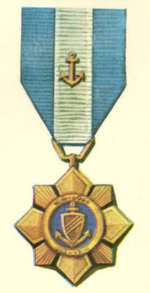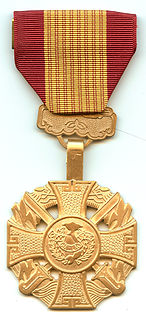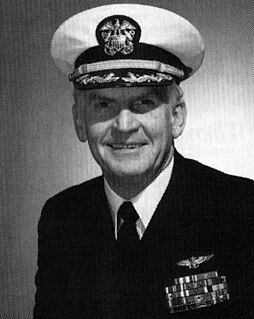| Vietnam Navy Gallantry Cross | |
|---|---|
 Navy Gallantry Cross with Bronze Anchor | |
| Awarded by | |
| Type | Military decoration |
| Eligibility | Military personnel who were engaged in naval combat |
| Awarded for | Meritorious or heroic conduct while engaged in naval combat |
| Status | No longer awarded |
| Precedence | |
| Next (higher) | Air Gallantry Cross [1] |
| Next (lower) | Hazardous Service Medal [1] |
| Related | The American equivalent is the Legion of Merit |
Gold anchor ribbon Silver anchor ribbon Bronze anchor ribbon | |
The Vietnam Navy Gallantry Cross (Vietnamese : Hải-Dũng Bội-Tinh) was a military decoration of South Vietnam which was issued during the years of the Vietnam War. The Navy Gallantry Cross was awarded to any member of the military who displayed meritorious or heroic combat while engaged in naval operations to benefit South Vietnam. The medal was awarded both for combat and non-combat service and was the equivalent of the United States Legion of Merit.

Vietnamese is an Austroasiatic language that originated in Vietnam, where it is the national and official language. It is the native language of the Vietnamese (Kinh) people, as well as a first or second language for the many ethnic minorities of Vietnam. As a result of Vietnamese emigration and cultural influence, Vietnamese speakers are found throughout the world, notably in East and Southeast Asia, North America, Australia and Western Europe. Vietnamese has also been officially recognized as a minority language in the Czech Republic.

South Vietnam, officially the Republic of Vietnam, was a country that existed from 1955 to 1975, the period when the southern portion of Vietnam was a member of the Western Bloc during part of the Cold War. It received international recognition in 1949 as the "State of Vietnam", which was a constitutional monarchy (1949–1955). This became the "Republic of Vietnam" in 1955. Its capital was Saigon. South Vietnam was bordered by North Vietnam to the north, Laos to the northwest, Cambodia to the southwest, Thailand across the Gulf of Thailand to the southwest, and the Philippines, Malaysia, Brunei, and Indonesia across the South China Sea to the east and southeast.

The Vietnam War, also known as the Second Indochina War, and in Vietnam as the Resistance War Against America or simply the American War, was an undeclared war in Vietnam, Laos, and Cambodia from 1 November 1955 to the fall of Saigon on 30 April 1975. It was the second of the Indochina Wars and was officially fought between North Vietnam and South Vietnam. North Vietnam was supported by the Soviet Union, China, and other communist allies; South Vietnam was supported by the United States, South Korea, the Philippines, Australia, Thailand and other anti-communist allies. The war is considered a Cold War-era proxy war from some US perspectives. It lasted some 19 years with direct U.S. involvement ending in 1973 following the Paris Peace Accords, and included the Laotian Civil War and the Cambodian Civil War, resulting in all three countries becoming communist states in 1975.
Contents
The Navy Gallantry Cross was also awarded to members of foreign military forces, provided that such service members were engaged in direct operational support of Vietnam and that such naval actions benefitted the Vietnamese military. Officers of the United States Navy were frequently awarded the Navy Gallantry Cross.

The United States Navy (USN) is the naval warfare service branch of the United States Armed Forces and one of the seven uniformed services of the United States. It is the largest and most capable navy in the world and it has been estimated that in terms of tonnage of its active battle fleet alone, it is larger than the next 13 navies combined, which includes 11 U.S. allies or partner nations. with the highest combined battle fleet tonnage and the world's largest aircraft carrier fleet, with eleven in service, and two new carriers under construction. With 319,421 personnel on active duty and 99,616 in the Ready Reserve, the Navy is the third largest of the service branches. It has 282 deployable combat vessels and more than 3,700 operational aircraft as of March 2018, making it the second-largest air force in the world, after the United States Air Force.
Similar decorations existed for general service and air service, and were known as the Vietnam Gallantry Cross and Vietnam Air Gallantry Cross. These were separate decorations from the Vietnam Navy Gallantry Cross which came in three different grades: with gold anchor, silver anchor, and bronze anchor.










